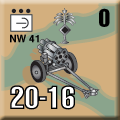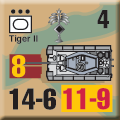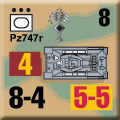| Afrika 1944:
Scenario Preview, Part 1
By Mike Bennighof, Ph.D.
August 2019
 I started out writing the scenarios for Panzer Grenadier: Afrika 1944 treating it pretty much like one of the historical supplements, except it would be based on a fictional rather than a historical campaign. Some ways into it, it struck me that I wasn’t taking full advantage of the situation. I had set the story in Morocco, and I really wanted to start the action with a couple of amphibious landings. I started out writing the scenarios for Panzer Grenadier: Afrika 1944 treating it pretty much like one of the historical supplements, except it would be based on a fictional rather than a historical campaign. Some ways into it, it struck me that I wasn’t taking full advantage of the situation. I had set the story in Morocco, and I really wanted to start the action with a couple of amphibious landings.
We’ve published a huge number of Panzer Grenadier mapboards (111 including Modern and Infantry Attacks games, though some of them have fallen out of print), yet only three of them are beachfront property: two from Saipan 1944, and one from Marianas 1944. I looked hard at the Saipan maps, but they just didn’t look like Morocco. Then it struck me. They did look like the Canary Islands. And if we used Saipan 1944 for its maps, then we’d have Marine pieces. Marines that could fight the Afrika Korps. And so the first chapter of Afrika 1944 (actually the last one designed) came to be. Let’s have a look at its scenarios.
Chapter One
The Invasion of Tenerife
The Allied invasion of North Africa would begin with landings in the Spanish-ruled Canary Islands. Aircraft based there could support the invasion of Morocco, and the islands’ ports would provide staging sites for the amphibious forces.
A division of American Marines would spearhead the assault on Tenerife, the islands’ administrative, cultural and economic center. A German garrison defended the key islands of Tenerife and Gran Canaria, with Spanish troops protecting the other, less important islands.
Scenario One
Beaches of Radazul
April 1944
 The Americans came ashore on Tenerife south-west of the capital of Santa Cruz and its vital airfield. American battleships and cruisers softened up the defenses first with a heavy bombardment, while carrier planes struck targets further inland and covered the invasion fleet from enemy air attack. The German defenders, already isolated by an Allied naval blockade, had expected an attack for weeks. The Americans came ashore on Tenerife south-west of the capital of Santa Cruz and its vital airfield. American battleships and cruisers softened up the defenses first with a heavy bombardment, while carrier planes struck targets further inland and covered the invasion fleet from enemy air attack. The German defenders, already isolated by an Allied naval blockade, had expected an attack for weeks.
Conclusion
The Marines carried the day, securing their beachhead against strong opposition backed by heavy artillery support. The Germans had expected a landing by the Allies, but had not been prepared for the mobility the Marines gained from their amphibious tractors or the overwhelming firepower of the Marine rifle platoons.
Notes
It’s a massive 1944 Marines-storming-the-beach landing, except this time the defenders are the Afrika Korps and they have rocket launchers, 88mm guns and more in store for the Marines. They’re going to need them all, because the Marines have the Navy on their side.
Scenario Two
Advance on Santa Cruz
April 1944
In accordance with their plans, the Marines now marched northward on the colony’s capital Santa Cruz, which also had a crucial airfield. Tanks and artillery had already come across the beaches, as years of training and planning bore fruit. The speed of the Marines’ recovery from the landing surprised the Germans, who attempted to block the advance as best they could.
Conclusion
The Marines forced the Germans out of their positions, flanking their roadblock and continuing the advance against Santa Cruz de Tenerife. The Marine rifle platoons with their cadres of long-service regulars and steady infantry training could not be held back. But the Germans had not expended all of their defensive abilities.
Notes
This is one of the few small scenarios in the Afrika 1944 set, a pretty tough infantry fight with the Marines using all of their fortification-busting weapons and tactics deployed against the Japanese in our reality against the Afrika Korps here in the sunny Canary Islands.
Scenario Three
Gyrenes and Panzers
April 1944
 Anxious to push back the advancing Marines, the island’s garrison command committed a mechanized battalion, a rocket launcher battalion and companies of tanks and assault guns from their operational reserve. Now it was the Marines’ turn to be surprised, as they had expected the Germans to deploy tanks against them even on the beaches but were not prepared for the size, firepower and armor of their opponents’ machines. And these were decidedly second-line tanks. Anxious to push back the advancing Marines, the island’s garrison command committed a mechanized battalion, a rocket launcher battalion and companies of tanks and assault guns from their operational reserve. Now it was the Marines’ turn to be surprised, as they had expected the Germans to deploy tanks against them even on the beaches but were not prepared for the size, firepower and armor of their opponents’ machines. And these were decidedly second-line tanks.
Conclusion
The Marines had few weapons that could defeat the German tanks, and resorted to engaging them in hand-to-hand combat with demolition charges and flaming bottles of gasoline. Holland M. Smith, commander of the Atlantic Fleet Amphibious Force, ordered the Marines’ secret weapon landed and sent to the front immediately.
Notes
The Afrika Korps counter-attacks, with assault guns and T-34 tanks (yes, T-34 tanks). The Marines have a handful of Shermans but no anti-tank guns. They’ll have to use their Marine fighting skills and k-bar combat knives to stop the panzers.
Scenario Four
Resistance at San Cristóbal
April 1944
German resistance stiffened as the Marines approached Santa Cruz and its large port, the reason for the American invasion. First Marine Division had lost most of its tanks, but deployed its reserve tank company and the full three battalions of the 7th Marines plus an additional battalion to capture the inland town of San Cristóbal de La Laguna and its airfield.
Conclusion
The frontal assault succeeded through sheer weight of numbers and firepower, leaving the airfield in American hands by the end of the day. The Marines fought to expand their perimeter around San Cristóbal even as U.S. Navy construction engineers, the famed Seabees, worked to bring the airfield into service.
Notes
This time it’s the Marines with the super-tanks, as the Germans have nothing that can match the firepower of the Pershing tank. They do have a lot of medium tanks, and the Marines will need their numbers (and they have big numbers) and their massive air and artillery support to move forward.
Scenario Five
Panzers of Tenerife
April 1944
 With San Cristóbal fallen and the capital of Santa Cruz under dire threat, the German command committed its entire mechanized reserve to a counter-attack. They had little hope of preventing the island’s fall, but hoped to delay it long enough for the Italian battle fleet to exit the Mediterranean and drive off the American invasion fleet. The Marines had borrowed some additional armor, but remained woefully outmatched. With San Cristóbal fallen and the capital of Santa Cruz under dire threat, the German command committed its entire mechanized reserve to a counter-attack. They had little hope of preventing the island’s fall, but hoped to delay it long enough for the Italian battle fleet to exit the Mediterranean and drive off the American invasion fleet. The Marines had borrowed some additional armor, but remained woefully outmatched.
Conclusion
The U.S. Army tankers fought hard alongside the Marines, but only the handful of Marine Pershing tanks could stop the German Tiger tanks. The Marine rifle companies pushed ahead steadily, aided by ample use of flamethrowers plus air support and naval gunfire. At the cost of heavy casualties the Marines finally took Santa Cruz and its port, opening the gateway for more reinforcements and equipment to pour onto the island.
Notes
Now we get a big tank battle amid the palms and sugar cane of Tenerife, with Army Shermans and Marine Pershings against Tigers and T-34’s. The Germans have the tanks, but the Americans have air and artillery support plus they have Marines.
Scenario Six
Beaches of Tejita
April 1944
On the south-western coast of Tenerife, a small Marine landing force would target a German-built airfield. Aerial reconnaissance showed only a small defending force in place to protect the installation. With cruisers and destroyers providing offshore gunfire and carrier planes overhead, the Marines expected to quickly deal with the second-line garrison troops.
Conclusion
Aided by overwhelming firepower, the Marines steadily overcame the German paratroopers who fought tenaciously for every entrenchment and had to be winkled out with liberal use of flamethrowers. The German island command had not intended to use its small airborne element in the defensive role, hoping to hold them at the airfield for a sudden surprise deployment elsewhere.
Notes
We wrap this chapter with a smaller landing, as the Marines face a garrison of German paratroopers. I couldn’t pass up the chance to have Marines fighting against fallschirmjäger. The Germans are pretty tough, but so are the Marines. And they have a gunboat.
 And that’s Chapter One, which winds up with a Battle Game. Next, we’ll look at . . . Chapter Two. And that’s Chapter One, which winds up with a Battle Game. Next, we’ll look at . . . Chapter Two.
Click right here to order Afrika 1944 right now.
Sign up for our newsletter right here. Your info will never be sold or transferred; we'll just use it to update you on new games and new offers.
Mike Bennighof is president of Avalanche Press and holds a doctorate in history from Emory University. A Fulbright Scholar and award-winning journalist, he has published over 100 books, games and articles on historical subjects.
He lives in Birmingham, Alabama with his wife, three children and his dog, Leopold. Leopold is currently in print.
|
